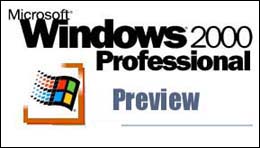Hardware
Audio
Controllers
General
Mainboards
Modems
Monitors
Portables
Printers
Processors
Scanners
Storage
Video
Games
Reviews
Previews
Cheats
& Hints
News
General Info
Microsoft
Windows 2000
Developer Microsoft Corporation Review
by Nirudha Perera
|
 |
Microsoft Windows, the object of both love and hate of many a man (and woman). Either way you look at it, Windows and the direction it takes in the future affects all of us in the computer industry. Having dominated the desktop market for so long, it must be odd for Microsoft to see so much media and popular attention drawn towards other "upstart" OS’s. So what does one do to try and secure the future? "Windows Everywhere" is Microsoft’s answer.
We
have Windows CE on the smaller end of the spectrum. It has managed a good
reception from the PDA industry. But when it comes to the less visible
consumer embedded market the likes of QNX and Chorus still hold sway. On
the server end, we have the various incarnations of Windows NT (New Technology).
A pretty good OS, though it has been criticized for it's resource hungriness
and lack of scalability. The workstation version of NT is supposed to be
the OS of choice for the business desktop but limitations in hardware support
and the lack of power management features has limited its success. The
most successful member of the Windows family is without a doubt Windows
9x (9x denoting Windows 95 as well as 98, which is an enhancement of 95).
Win9x has probably the best hardware support of any OS.
It
also has the oh-so important (for the average consumer, anyway) large software
base of entertainment titles. The problem is (as so many people will readily
point out) that Windows 9x is pretty lacking in terms of technology. Sure,
it has DirectX but it still has DOS underpinnings. It does not support
any new generation file systems. It's a hodge-podge of new 32-bit code
and older 16-bit code. It is also prone to crashing with bad applications,
which is considered very poor manners in a host OS.
For the future, Microsoft have (very wisely, I think) decided to base all versions of their OS on Windows NT technology. Even Windows CE uses a well-defined subset of the Win32 API found in NT. Since NT has certain problems (which I pointed out earlier) to overcome before it could gain mass-market acceptance, it has to be fixed as well. Rather than just taking the old code and adding stuff and rewriting bits (which has been the case up to now) Microsoft have opted to take the harder and costlier route of rewriting NT from scratch! While people are worried about bugs which will take time to be uncovered in a brand new code base, this definitely seems to be the "right thing" to do. It also explains the very long beta period of the OS. The only way to find bugs in a whole new code base is to get it up and running and in use in real life conditions, which was what the public beta program of Windows 2000 was about.
This
is a look at Windows 2000 Professional from the outside. It is not really
a thorough examination of changes made to the kernel and whatnot. I present
my experience with it so far and some of the features you get to play with
and what it looks like.
|
|